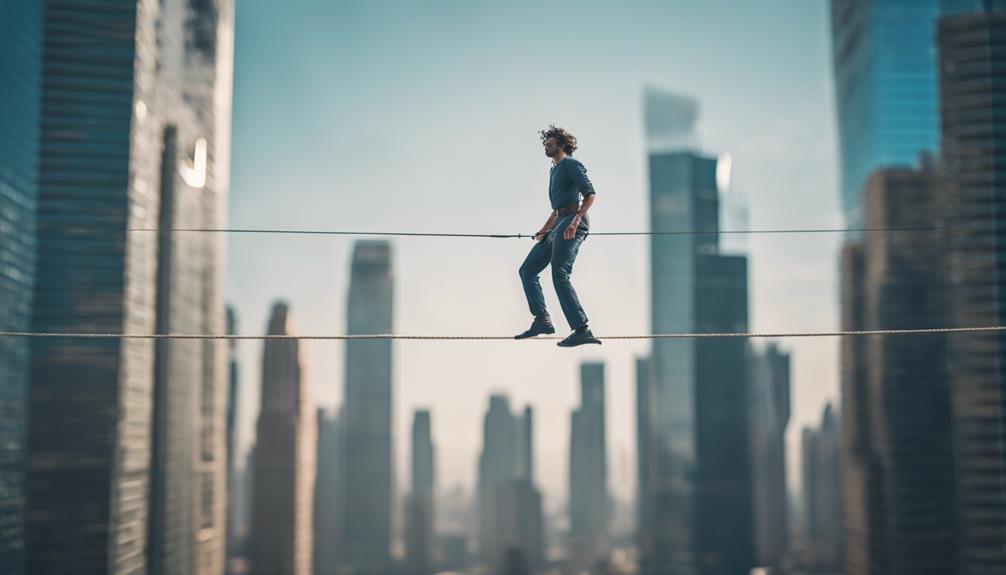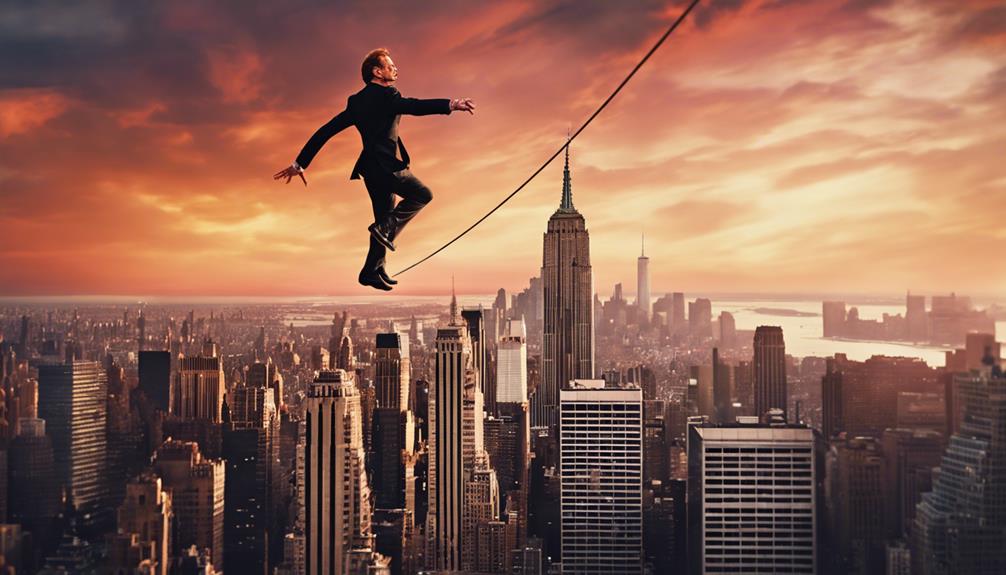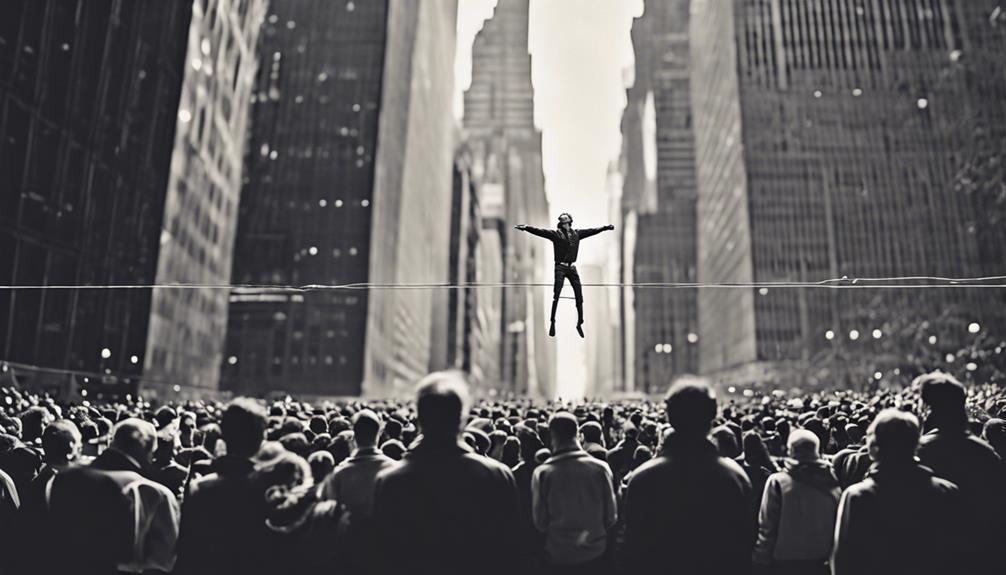Philippe Petit, dubbed the man who walked between the towers, pulled off an astonishing tightrope walk between New York's Twin Towers on August 7, 1974. Against all odds, he spent six years meticulously planning this daring feat, which lasted around 45 minutes. No safety net accompanied him, earning the act the title of the ‘artistic crime of the century.' Crowds gathered below, mesmerized by his grace and courage. Petit's performance transformed the Towers into symbols of artistic bravery, leaving a lasting legacy. If you're curious about the impact of this remarkable event, there's so much more to uncover.
Background Information
Philippe Petit's journey into tightrope walking started in his childhood, fueled by a fascination with magic and juggling.
By 1974, he'd transformed that passion into a breathtaking high-wire walk between the Twin Towers.
Before this iconic feat, he honed his skills through various performances, showcasing his unique talent and determination.
Childhood Fascination With Tightrope Walking
From a young age, a fascination with magic, juggling, and climbing ignited a passion for tightrope walking that would shape Philippe Petit's extraordinary life. His journey into this high-wire art began at 16, as he taught himself various wire tricks and honed his skills. You can imagine him as a teenager, creating fake IDs to sneak onto rooftops, practicing in secret while the world bustled below. Each step he took on those precarious lines was a dance with danger, but it only fueled his excitement.
Philippe's admiration for towering structures, particularly the Twin Towers, blossomed when he learned about them at 18. This infatuation with heights propelled him to engage in meticulous preparation for his future endeavors. He dedicated time to extensive research, interviewing experts to understand construction techniques and safety measures.
This groundwork was essential, not just for mastering tightrope walking, but for envisioning his daring performances that would later capture the world's attention. His early experiences and relentless pursuit of perfection laid the foundation for the breathtaking feats that would define him as a legendary high-wire artist.
First High-Wire Walk in 1974
After years of preparation and a deep-rooted passion for tightrope walking, the moment arrived when Philippe Petit executed his breathtaking high-wire walk between the Twin Towers in 1974.
On August 7, 1974, he stepped onto a wire strung 1,350 feet above the ground, showcasing his incredible skill and daring spirit. Petit's performance lasted approximately 45 minutes, during which he walked, laid down, and even saluted the crowd gathered below in lower Manhattan.
His meticulous planning spanned six years, involving detailed study of the Towers' construction and careful securing of materials for the rigging. With no safety net beneath him, Petit transformed this act into what many dubbed the ‘artistic crime of the century.'
Thousands of onlookers watched in awe as he balanced high above the city, creating a spectacle that would be etched in history.
This daring feat not only captivated the crowd but also led to Petit's arrest for trespassing. Yet, the thrill of that high-wire walk between the Twin Towers remains a demonstration of his extraordinary talent and unyielding determination.
Previous High-Wire Performances
Long before the iconic walk between the Twin Towers, Philippe Petit built his reputation with daring high-wire performances, including a stunning act between the towers of Notre-Dame Cathedral in 1971. This breathtaking feat captivated audiences and established him as a fearless high-wire artist.
Petit's journey didn't stop there; in 1973, he further showcased his skill by executing a high-wire walk between the two arches of the Sydney Harbour Bridge. Each of these performances wasn't just a display of courage but also a reflection of his meticulous planning and preparation.
Petit also honed his craft at the annual circus in the Parisian suburb of Saint-Denis, where he gained invaluable experience performing for live audiences. His earlier acts, like the tightrope walk over the Puy de Dôme in France, were vital in building the confidence necessary for his ambitious Twin Towers walk.
Each experience contributed to his ultimate artistic vision, allowing him to dream big. By the time he set his sights on the Twin Towers, Petit wasn't only ready but also determined to push the boundaries of high-wire artistry.
Current Updates or Main Focus

You're about to discover how Philippe Petit's artistic journey continues to evolve today.
From upcoming art installations to collaborations with musicians, he's seamlessly shifted into the visual arts world.
Let's explore how these current projects highlight his enduring legacy and creative spirit.
Upcoming Art Installations
Upcoming art installations inspired by Philippe Petit's daring high-wire walk will celebrate the creativity and courage associated with the Twin Towers. These installations aim to honor not just Petit's remarkable feat but also the resilience of the city.
You'll find that many of the upcoming art installations feature interactive elements, allowing you to experience the thrill of tightrope walking through immersive virtual reality simulations.
Exhibitions will showcase multimedia displays, including enthralling photographs, video footage, and artistic interpretations of Petit's iconic performance. You'll encounter collaborative projects with local artists that explore themes of risk and the historical significance of the Twin Towers. Each piece will provide a unique perspective on the impact of Petit's walk and its enduring legacy.
These installations are set to be revealed at significant cultural venues in New York City, coinciding with anniversaries related to the Twin Towers and Petit's incredible journey. As you explore these exhibits, you'll not only celebrate an extraordinary moment in history but also reflect on the spirit of creativity that continues to inspire generations.
Don't miss this opportunity to connect with art that embodies courage and innovation.
Transition to Visual Arts
Philippe Petit has seamlessly shifted from high-wire performances to the visual arts, using various mediums to express the creativity and thrill of his historic walk between the Twin Towers. As a high-wire artist, he captures the essence of balance and risk in his artwork, creating pieces that resonate with both art enthusiasts and those familiar with his daring feats. His photographs and drawings showcase the landscapes he traversed, reflecting the impermanence of monumental structures.
In recent years, Petit has engaged deeply with the visual arts community, participating in art exhibitions that highlight his unique perspective. His work often inspires artistic collaborations, merging visual art with live performances that emphasize storytelling and aerial artistry. Through these initiatives, he explores the intersection of art and risk-taking, encouraging audiences to embrace their own creative journeys.
Additionally, Petit conducts workshops and lectures, sharing his insights and experiences with a new generation of artists. By guiding others in understanding the delicate balance between creativity and risk, he fosters an environment where innovation can thrive. This ensures that his legacy as a high-wire artist continues to inspire future artists in the visual arts domain.
Artistic Collaborations With Musicians
Building on his artistic journey, Petit's collaborations with musicians vividly illustrate how he intertwines the thrill of high-wire artistry with the emotive power of music.
Philippe Petit's influence has sparked numerous musical tributes, with bands like Incubus, U2, and The Script referencing his breathtaking high-wire walk. These artistic collaborations showcase the cultural impact of his performances and highlight emotional themes that resonate deeply with audiences.
In 2015, the film 'The Walk' featured a soundtrack that captured the essence of Petit's daring act, further emphasizing the connection between sound and visual art. His interdisciplinary collaborations go beyond traditional music; they incorporate live performances that blend dance and high-wire art, creating a unique experience for spectators.
In 2022, Petit partnered with composer Philippe Eidel to craft a mesmerizing soundscape that complemented his live high-wire acts, enriching the audience's experience.
This commitment to merging tightrope walking with music reflects his desire to inspire future generations of artists to explore the limitless possibilities of artistic collaborations. Through these efforts, Philippe Petit continues to redefine the boundaries of performance art.
Detailed Analysis

When you think about Philippe Petit's iconic walk, it sparks a conversation about the impact of high-wire art installations today.
You might consider how media coverage shaped public perception of his daring feat and how themes of balance and freedom resonate in today's world.
Let's explore these points and see how they connect to Petit's legacy.
Recent High-Wire Art Installations
Recent high-wire art installations celebrate the legacy of Philippe Petit by exploring themes of balance and risk in urban settings. These installations pay homage to the daring spirit of Petit, a renowned high-wire artist, who captivated audiences with his breathtaking performances. Notable examples include Nik Wallenda's 'High Wire,' where he performed across various locations, echoing Petit's audacity and artistry.
In 2021, the 'Skywalk' installation in France allowed participants to experience the thrill of walking on a suspended wire, drawing inspiration from Petit's remarkable feats. Meanwhile, the 'Between the Towers' installation in New York featured a wire strung between buildings, inviting artists to perform and engage with the public—a direct nod to Petit's historic walk between the Twin Towers.
Many contemporary installations incorporate interactive elements, enabling audiences to grasp the delicate balance and inherent risk associated with high-wire walking. Through these artistic endeavors, you can appreciate not only the physical challenges but also the emotional resonance of performance art, ensuring that Philippe Petit's legacy continues to inspire and provoke thought in urban landscapes worldwide.
Media Coverage and Public Perception
Media coverage of Philippe Petit's daring high-wire walk in 1974 captured the attention of the world, painting it as the 'artistic crime of the century' and igniting public fascination. Major news outlets highlighted the audacity of his performance between the Twin Towers, transforming the skyscrapers from symbols of urban monotony into icons of artistic bravery. This extensive media coverage not only amplified Petit's notoriety but also reshaped public perception, endearing him to both local New Yorkers and international audiences.
After his arrest for trespassing and disorderly conduct, Petit's agreement to perform for children in Central Park further enhanced his image, showcasing his commitment to art and community. Even years later, the documentary 'Man on Wire' reignited interest in his story, reminding viewers of the cultural significance of the Twin Towers.
In the wake of the tragic events of September 11, 2001, public perception evolved even further. Many began to regard Petit's high-wire act as a symbol of resilience and artistic expression amidst loss, enriching the narrative surrounding the 9/11 Memorial and the legacy of the Twin Towers.
Reflections on Balance and Freedom
Philippe Petit's high-wire walk between the Twin Towers consistently evokes reflections on the delicate balance between risk and freedom, revealing profound insights into the human spirit's quest to transcend limitations.
As you consider this breathtaking feat, you realize that it symbolizes more than just a daring act; it embodies the meticulous planning and preparation Petit undertook over six years to achieve personal freedom.
Standing 1,350 feet above ground, he danced on the wire, illustrating an artistry that few could comprehend. Each moment spent up there was a demonstration of the human spirit's relentless pursuit of balance amidst fear and uncertainty. You can't help but recognize the transient nature of such experiences; they're fleeting yet powerful.
The Twin Towers themselves served as a backdrop to this extraordinary performance, representing both monumental ambition and the impermanence of human achievements.
Petit's reflections remind you that true freedom often lies in moments that challenge you to confront your limits. His walk wasn't merely an act of defiance against gravity; it was a celebration of life, urging you to embrace the balance between risk and the exhilarating taste of freedom.
Public Reaction or Expert Opinions

You might be surprised by the viral videos that captured Philippe Petit's breathtaking stunts, sparking both applause and critique from audiences.
Experts have weighed in on his techniques, offering insights into the remarkable skills that made his walk possible.
Let's explore how public reaction and professional opinions shaped the legacy of this iconic performance.
Viral Videos of Petit's Stunts
Viral videos of Petit's breathtaking high-wire walk between the Twin Towers have sparked a wave of admiration and disbelief among viewers, showcasing not only his incredible skill but also the emotional weight of the iconic structures themselves.
As a high-wire artist, Philippe Petit mesmerizes audiences with his daring performance art, leaving many in awe of his bravery and precision.
These viral videos, often featuring stunning aerial shots of the Twin Towers, capture the graceful movements and tension of Petit's act. The public reaction is overwhelmingly positive, with countless comments praising his talent and the sheer audacity of the stunt.
Many viewers express a deep emotional connection to the Twin Towers, reflecting on their significance and tragic history, which adds layers of meaning to Petit's performance.
Experts in performance art and acrobatics analyze the videos, highlighting the meticulous planning and physical prowess required for such a feat. This further amplifies Petit's status as a cultural landmark in both performance art and cinematic history.
As you watch these clips, consider the blend of artistry, courage, and the poignant backdrop of the Twin Towers that continues to inspire admiration worldwide.
Audience Applause and Critiques
Onlookers in lower Manhattan erupted in applause as Petit gracefully traversed the high wire, captivated by the blend of danger and artistry that defined his historic performance. The crowd's reaction was electric, with cheers echoing through the streets, celebrating what many called the 'artistic crime of the century.' This audacious act not only showcased Philippe Petit's incredible talent but also transformed public perception of the Twin Towers, turning them into symbols of artistic expression rather than mere structures.
Media coverage of the performance further amplified the admiration, with dramatic visuals capturing Petit's daring walk, drawing in viewers from all over. After his arrest, the public rallied behind Petit, expressing overwhelming support. Many even advocated for his release, leading to a unique arrangement where he performed for children in Central Park. This act of goodwill solidified his status as a beloved figure in the city.
Ultimately, Petit's performance did more than entertain; it ignited a sense of wonder and possibility among spectators, leaving a lasting legacy that intertwined the Twin Towers with human achievement and artistic bravery.
Professional Insights on Petit's Techniques
Philippe Petit's innovative techniques, from his meticulous planning to his enchanting performance style, not only showcased his extraordinary skills but also transformed public perception of high-wire artistry. His commitment to preparation was unparalleled; he spent six years studying the Twin Towers' construction and wind patterns, ensuring his safety while executing this breathtaking feat. This meticulous planning revealed his innovative approach as a high-wire artist, enthralling audiences and critics alike.
During his performance, Petit employed diverse techniques—walking, dancing, lying down, and saluting the crowd—engaging viewers in ways that transcended mere spectacle. Experts labeled his act as the ‘artistic crime of the century,' emphasizing the blend of audacity and artistry in his work. This shift in perspective turned him from a perceived criminal into a celebrated performer, demonstrating how talent can reshape public opinion.
The aftermath of his walk led to an unexpected community service sentence, where he performed for children, further solidifying his status as an admired artist. Through his unique performance techniques and innovative approach, Philippe Petit not only pushed the boundaries of high-wire artistry but also paved the way for future generations of performers.
Broader Implications

Philippe Petit's daring walk changed the game for high-wire performances, pushing boundaries and setting new standards.
You can see how his techniques inspired a wave of innovation in the art form, encouraging performers to take greater risks.
Ultimately, Petit became a cultural icon of fearlessness, reminding us all of the power of ambition and creativity.
Revolutionized High-Wire Performance Standards
The breathtaking high-wire walk between the Twin Towers in 1974 transformed performance standards, blending artistry with technical prowess at staggering heights and inspiring future generations to reimagine the limits of their craft. Philippe Petit, a daring high-wire artist, pulled off what many called the 'artistic crime of the century.'
His feat wasn't just about the act itself but the meticulous planning that went into it over six years. You learn the importance of risk assessment from his journey; Petit understood the potential dangers yet chose to embrace them, walking 1,350 feet above the ground without a safety net.
This redefined expectations for safety in high-wire performances, igniting a dialogue about the delicate balance between risk and artistic expression. The cultural impact of Petit's walk is profound—enthusiasm for high-wire acts surged, encouraging other performers to push boundaries and innovate.
New High-Wire Performance Techniques
Innovative high-wire techniques, born from Petit's daring feats, have reshaped the landscape of aerial performance, blending artistry with safety and precision. High-wire artist Philippe Petit revolutionized the way performers approach their craft, emphasizing the importance of meticulous planning when rigging the wire. He mastered environmental conditions, studying factors like wind and tower swaying to guarantee a stable performance in the sky.
By using a balancing pole, Petit not only enhanced his stability but also added an artistic element to his act, showcasing the beauty of movement. His approach encourages performers to incorporate theatricality into their routines, transforming high-wire acts into fascinating experiences rather than mere displays of courage.
Petit's ingenious techniques, such as shooting a fishing line with a bow and arrow to set up his wire, have inspired future generations. They now understand that successful high-wire performances require a fusion of technical skill and creativity.
As you explore this aerial art form, consider how these innovative high-wire performance techniques can elevate your own work, making it both a thrilling spectacle and a profound artistic expression.
Cultural Icon of Fearlessness
Petit's breathtaking high-wire walk between the Twin Towers has become a powerful symbol of fearlessness, inspiring countless individuals to pursue their passions against all odds. This audacious act, often labeled the ‘artistic crime of the century,' showcases how determination and creativity can triumph over seemingly insurmountable challenges.
Philippe Petit's meticulous planning, which spanned six years, underscores the importance of resilience and preparation in achieving extraordinary feats. His high-wire walk not only transformed the Twin Towers into icons of artistic expression but also elevated Petit to the status of a cultural icon.
The media frenzy surrounding his achievement painted a vivid picture of bravery, encouraging people to embrace their own dreams fearlessly. In a world that often seems filled with obstacles, Petit's act serves as a reminder that pursuing one's passion isn't just possible but essential.
After the tragic events of September 11, 2001, Petit's emotional connection to the towers deepened. His willingness to perform again if they were rebuilt further solidified his legacy as a beacon of hope and fearlessness in the face of adversity, inspiring generations to confront their fears and reach for greatness.
Frequently Asked Questions
Did Philippe Petit Actually Walk the Twin Towers?
Yes, you can find evidence that Philippe Petit did walk between the Twin Towers. His daring high-wire act captivated audiences and showcased his incredible skill, determination, and meticulous planning, making it a legendary moment in history.
Is the Story "The Man Who Walked Between the Towers" True?
Yes, the story is true. It recounts a remarkable event where an individual performed a daring high-wire walk between two towering structures, enthralling audiences and showcasing extraordinary skill, audacity, and meticulous planning over several years.
How Old Was Philippe Petit When He Walked the Twin Towers?
Philippe Petit was 24 years old when he walked between the Twin Towers. His age reflects not just youthful ambition but also years of dedication and practice that led to this extraordinary achievement.
What Is the Theme of the Man Who Walked Between the Towers?
The theme emphasizes courage and the pursuit of dreams. It highlights the importance of passion, dedication, and the fleeting nature of achievements, inspiring you to embrace ambition and reflect on the beauty of extraordinary acts.
What Contributions Did Stanley Robinson Make in Comparison to Philippe Petit’s Feat?
Stanley robinson biography and legacy have largely focused on his significant contributions to the field of science fiction literature. In comparison to Philippe Petit’s feat of walking between the Twin Towers, Robinson’s impact in the literary world has been profound, shaping the genre and inspiring future writers with his innovative storytelling.
What Surprising New Role Has Philippe Petit Taken On?
Max brown actor surprising role has Philippe Petit taking on the new role of motivational speaker. Known for his high-wire walk between the Twin Towers in 1974, Petit is now inspiring audiences with his daring feats and storytelling. It’s a surprising turn for the fearless performer.
Conclusion
In reflecting on Philippe Petit's daring walk between the Twin Towers, you can't help but feel inspired by his audacity and artistry. His feat isn't just a moment in history; it symbolizes the human spirit's courage to challenge limits.
As you consider the public's reactions and the lasting impact of his performance, it's clear that Petit's legacy encourages you to take risks and embrace creativity in your own life. His story reminds you that boldness can lead to incredible moments.










